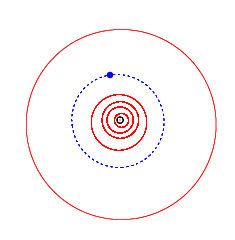 Orbits of Serpe (blue), the inner planets and Jupiter (outermost) | |
| Discovery [1] | |
|---|---|
| Discovered by | H. Debehogne |
| Discovery site | La Silla Obs. |
| Discovery date | 4 May 1992 |
| Designations | |
| (9968) Serpe | |
Named after | Jean Serpe (Belgian physicist) [2] |
| 1992 JS2 ·1977 VT 1985 SC2 ·1988 KR1 | |
| main-belt ·(middle) | |
| Orbital characteristics [1] | |
| Epoch 4 September 2017 (JD 2458000.5) | |
| Uncertainty parameter 0 | |
| Observation arc | 39.56 yr (14,451 days) |
| Aphelion | 2.6974 AU |
| Perihelion | 2.4354 AU |
| 2.5664 AU | |
| Eccentricity | 0.0510 |
| 4.11 yr (1,502 days) | |
| 346.96° | |
| 0° 14m 22.92s / day | |
| Inclination | 12.993° |
| 213.10° | |
| 78.256° | |
| Physical characteristics | |
| Dimensions | 12.355±0.453 km [3] |
| 0.088±0.011 [3] | |
| 13.0 [1] | |
9968 Serpe, provisional designation 1992 JS2, is an asteroid from the middle regions of the asteroid belt, approximately 12 kilometers in diameter. This asteroid was discovered on 4 May 1992, by Belgian astronomer Henri Debehogne at ESO's La Silla Observatory in northern Chile. It was named after Belgian theoretical-physicist Jean Serpe, [2] professor at University of Liège and member of the RASAB. [2] The official naming citation was published by the Minor Planet Center on 17 May 2011 ( M.P.C. 75102). [4]
Serpe orbits the Sun in the middle main-belt at a distance of 2.4–2.7 AU once every 4 years and 1 month (1,502 days). Its orbit has an eccentricity of 0.05 and an inclination of 13° with respect to the ecliptic. [1] In 1977, it was first observed as 1977 VT at Cerro El Roble Station in Argentina, extending the body's observation arc by 15 years prior to its official discovery at La Silla. [2]
According to the survey carried out by NASA's Wide-field Infrared Survey Explorer with its subsequent NEOWISE mission, the asteroid measures 12.355 kilometers in diameter and its surface has an albedo of 0.088. [3] As of 2017, no rotational lightcurve has been obtained of Serpe. The body's rotation period and shape, as well as its spectral type remain unknown. [1] [5]